Your Cart is Empty
Get your first 3 samples FREE! Use code: 3FREESAMPLES at checkout!
Get your first 3 samples FREE! Use code: 3FREESAMPLES at checkout!
Shop Products
What's Trending
Resources
Wallplanks® Blogs
The Best Top Coat Wood Finish
Pre-Applied Adhesive
Wallplanks® Blogs

View Blogs >
The Best Top Coat Wood Finish

Read More >
Pre-Applied Adhesive

Read More >
What Is the Difference Between a Board and a Plank?
January 26, 2024 3 min read

When it comes to home decor and interior design, finding the right materials is essential. One popular choice for adding a touch of elegance and warmth to your walls is paneling. While the terms "board" and "plank" are often used interchangeably, there are subtle differences between the two. This blog post will explore these distinctions and help you understand which option is best suited for your needs. So, let's delve deeper into the topic and discover the difference between a board and a plank!
Understanding Board Paneling
As the name suggests, board paneling refers to using individual boards to cover a surface. These boards are typically made from solid wood or a composite material, such as MDF (medium-density fiberboard). Board paneling often showcases the natural grains and textures of the wood, creating a rustic and timeless aesthetic.
Types of Board Paneling
Board panelingoptions can vary based on the width, thickness, and profile of the boards used. Here are a few common types:
- Beadboard: Beadboard paneling features narrow planks with a beaded groove in between. This style adds a subtle, vintage charm to any space.
- Shiplap: Shiplap paneling involves boards with a rabbet or groove on one edge and a corresponding ridge on the opposite edge, allowing them to interlock seamlessly. Shiplap is a popular choice to achieve a cozy and coastal-inspired look.
- Tongue and Groove: Tongue and groove board paneling incorporates a tongue along one edge of each board and a corresponding groove on the opposite edge. This design allows for a tight fit and minimizes the visibility of gaps.
Exploring Plank Paneling
Unlike board paneling, which uses individual boards, plank paneling involves using longer and wider planks that typically span the entire width of the wall or ceiling. Plank paneling often provides a more contemporary and seamless appearance.
Types of Plank Paneling
Like board paneling, there are various types of plank paneling available. Some common ones include:
- Peel and Stick: This innovative type of plank paneling doesn't require nails or adhesives, making it easy to install and remove. Peel and stick planks are typically made from engineered hardwood or vinyl, offering versatility in both design and application.
- Reclaimed Wood: Reclaimed wood plank paneling consists of repurposed wood from old barns, fences, or structures. The use of reclaimed wood adds character and a unique, sustainable touch to any space.
- Engineered Wood: Engineered wood planks are composed of multiple layers of wood veneers and plywood, providing a more stable and durable option than traditional solid wood. This type of plank paneling often replicates the look of various hardwood species.
Choosing the Right Option for Your Space
Now that we understand the difference between board and plank paneling, let's consider some factors to help you decide on your specific needs.
- Design Style: The choice between board and plank paneling depends on the overall design aesthetic you wish to achieve. With its visible individual boards, board paneling enhances a rustic or traditional atmosphere. On the other hand, plank paneling suits contemporary or streamlined interior themes. Consider the overall design of your space to choose the most appropriate option.
- Surface Area: The size of the surface area to be covered also plays a crucial role.For smaller spaces, such as an accent wall or half wall, board paneling can add interest without overwhelming the room. In contrast, larger spaces, such as a full-length wall, benefit from the sleek and continuous look provided by plank paneling.
- Budget and Maintenance: Consider your budget and long-term maintenance expectations when choosing between board and plank paneling. Solid wood boards may require more investment and maintenance than engineered wood or vinyl planks. Keep in mind the level of upkeep you are willing to commit to in the years to come.
Shop Wallplanks Today
While "board" and "plank" are often used interchangeably, it is crucial to understand their subtle differences when considering paneling for your walls. Board paneling utilizes individual boards, allowing for more visible texture and design possibilities. On the other hand, plank paneling involves longer and wider planks that provide a more seamless, contemporary appearance. Making the right choice depends on factors such as design style, surface area, budget, and maintenance requirements.
If you're ready to transform your living spaces with stylish and versatile paneling options, look no further than Wallplanks. With our extensive range of high-quality wood-based paneling products, Wallplanks offers a solution to suit every taste and decor style. Explore our collection, get inspired, and start your paneling journey!

